April 2023
Posted: 4/20/2023 11:14:01 AM
The cities of Orange and East Orange will receive assistance through the federal Thriving Communities Program to explore ways to implement improvements that will better connect their north and south sections across the divide of Interstate Route 280. This will enhance safety for walkers and bikers, livability and economic development, among other benefits.
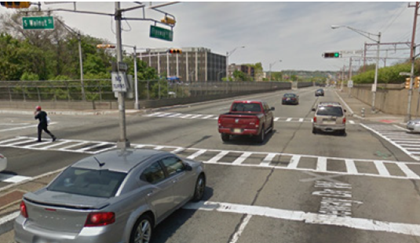 The improvements were identified in a 2017 Freeway Drive & Station Area Safety and Public Realm Study which was conducted by Essex County under NJTPA’s Subregional Studies Program. The study envisioned transforming Freeway Drive into a pedestrian- and bike-friendly multimodal thoroughfare. Currently it consists of east and west roadways at grade flanking I-280, which is depressed into a cut. Among other elements, the improvements would include dedicated bike lanes, new medians, street trees, upgraded lighting and public art. The thirteen bridges across I- 280 would be resized based on traffic volumes, with new traffic controls and sidewalk enhancements (including improved ADA compatibility) at intersections.
The improvements were identified in a 2017 Freeway Drive & Station Area Safety and Public Realm Study which was conducted by Essex County under NJTPA’s Subregional Studies Program. The study envisioned transforming Freeway Drive into a pedestrian- and bike-friendly multimodal thoroughfare. Currently it consists of east and west roadways at grade flanking I-280, which is depressed into a cut. Among other elements, the improvements would include dedicated bike lanes, new medians, street trees, upgraded lighting and public art. The thirteen bridges across I- 280 would be resized based on traffic volumes, with new traffic controls and sidewalk enhancements (including improved ADA compatibility) at intersections.
A key study goal was identifying ways to improve safe access to the three train stations – Orange, Brick Church and East Orange stations. An estimated 25 percent of area residents commute by transit. The study recommended phased implementation of the various improvements, and offered a long term vision of capping portions of the interstate to create new parks and development opportunities. 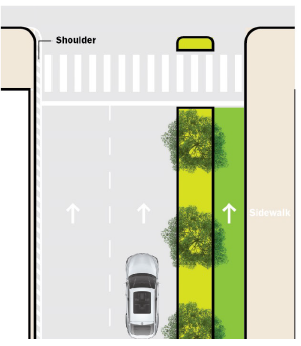
Under the award of assistance through the Thriving Communities Program, the cities will partner with the non-profit Housing and Neighborhood Development Services, Inc. (HANDS) to explore ways to advance the improvements – including preparing applications for grants under the federal Infrastructure Investment and Jobs Act (IIJA). They will also explore deploying innovative community engagement, workforce development, and clean technology strategies. Federally-designated “Capacity Builder” organizations, such as the Rocky Mountain Institute, will provide oversight and guidance.
One potential IIJA funding opportunity is the federal Reconnecting Communities program which aims to help reconnect communities that were previously cut off from economic opportunities by transportation infrastructure. Orange and East Orange faced such an economic loss, along other detrimental impacts, with the construction of Interstate 280 and Freeway Drive in the 1960s.
The 2017 study found that “Freeway Drive creates a significant physical, visual, and psychological divide between the residential areas to the south and the commercial areas and train stations to the north.” In addition, open space and recreational opportunities, it said “are almost non-existent” within the corridor. The roadway itself has greater capacity than is needed for its typical daily traffic volumes resulting in excessive vehicle speeds and danger to pedestrians.
The award of assistance under the Thriving Communities Program recognizes that the proposed improvements could become the kind of “transformative project” in an under-resourced and disadvantaged community the program was designed to support.
Posted: 4/18/2023 12:36:35 PM
Jersey City is remaking its streets to reduce speeds and create more space for walkers and bikers so even if crashes due to human error occur, they are less likely to result in injuries or fatalities. It’s part of the “safe systems approach” at the heart of the City’s Vision Zero Initiative.
Elias Guseman, senior transportation planner for Jersey City, presented an overview of Jersey City’s Vision Zero Initiative at the most recent meeting of the North Jersey Transportation Planning Authority’s (NJTPA) Regional Transportation Advisory Committee (RTAC) on April 10.
Jersey City Mayor Steven Fulop in 2018 signed a Vision Zero pledge to eliminate all traffic deaths by 2026. That goal led to an action plan that identified 77 action items led by multiple departments, agencies and stakeholders.
Since 2019, 50 of the 77 action items have been completed or are in progress, including: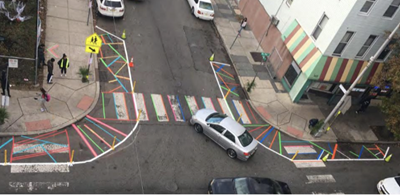
- 679 speed bumps
- 183 No Turn on Red restrictions
- 30+ active parklets
- 19 miles of protected bicycle lanes plus another 5 miles planned this year
- 124 curb extensions installed and 44 more planned
The Vision Zero action plan serves as a guiding document for all of the city's transportation work. “We try to pair this with the routine maintenance program and repaving for utility work,” Guseman said.
Engineering, planning and infrastructure action items often start out as demonstration projects using low-cost, quick build materials that allow for testing. That might include bike lanes, plazas, parklets, and traffic calming elements, like mini-roundabouts and curb extensions created with paint, bollards and planters.
The Newark Avenue pedestrian plaza started as a temporary quick-build project. Fairmount Triangle Park previously was a dangerous cut-through and a series of traffic islands.
A new protected bike lane on Marin Boulevard connects the bike lane networks of Jersey City and Hoboken.
Protected bike lanes and a reconfigured “floating” bus stop were added as part of a “road diet” for Columbus Drive.
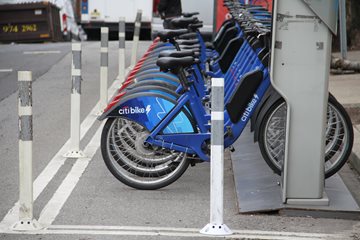
“We have seen correlation between adding this infrastructure and then more bicyclists have been using it," Guseman said. CitiBike ridership across Jersey City was up 22 percent between 2021 and 2022.
Like most of the country, Jersey City saw an increase in traffic fatalities in 2021, but no fatalities in 2022 -- the first time since 2016. Guseman called that a validation of the city’s efforts. “These interventions are working and we’re able to help reduce traffic fatalities on city roads we control and continue to work with state and county partners to improve roads throughout the city that we do not control."
Posted: 4/12/2023 10:07:46 AM
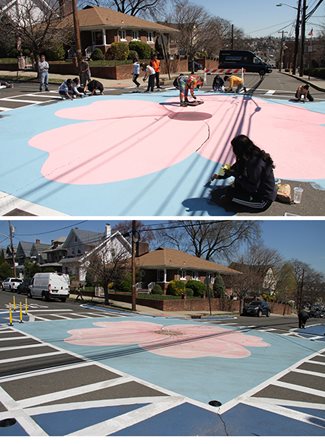 Crosswalks near a Belleville middle school are getting colorful curb extensions, painted by students and designed by a local artist, to help increase pedestrian safety and calm traffic. The upgrades are part of a demonstration project supported by NJTPA’s Complete Streets Technical Assistance program. Other communities can now undertake similar demonstration projects, drawing upon materials available through a new NJTPA Complete Streets Demonstration Library.
Crosswalks near a Belleville middle school are getting colorful curb extensions, painted by students and designed by a local artist, to help increase pedestrian safety and calm traffic. The upgrades are part of a demonstration project supported by NJTPA’s Complete Streets Technical Assistance program. Other communities can now undertake similar demonstration projects, drawing upon materials available through a new NJTPA Complete Streets Demonstration Library.
Belleville Township requested assistance from NJTPA with installing a temporary demonstration project at the intersection of Holmes and High Streets, adjacent to Belleville Middle School, both to improve travel safety and add art to the community.
The design includes painted curb extensions flanked by flexible posts and an art mural inside the intersection. The Township invited Belleville High School art club students to help paint it and then installed the delineator posts.
If successful, the Township will use the project to inspire similar installations elsewhere in the city. A survey at go.rutgers.edu/belleville asks residents for their thoughts on the upgrades.
Recognizing the value of similar projects, the NJTPA has established a Complete Streets Demonstration Library to allow communities to borrow needed materials for their own demonstrations. Since these temporary interventions take place within the street, they require demarcation with paint, signage, movable bollards, movable curbs, and other traffic control devices, all of which are available to borrow though this program.
The demonstration projects take a Complete Streets approach to creating safer, more livable streets for all road users. Questions and referrals should be sent to [email protected].
Posted: 4/10/2023 4:10:55 PM
The potential off-shore wind market in the U.S. is estimated to be two times the current U.S. electric energy use and the North Atlantic region is poised play a big part in an industry that’s expected to create thousands of related manufacturing and maritime jobs.
The Metropolitan Area Planning (MAP) Forum’s Multi-State Freight Working Group recently hosted an online workshop, “Off-Shore Wind Development Needs and Implications for Regional Planning and Transportation.” A recording of the workshop is available here.
The MAP Forum, created in 2008, is a consortium of 10 Metropolitan Planning Organizations (MPOs) and Councils of Government (COGs) from Connecticut, New Jersey, New York and Pennsylvania which coordinate planning activities in the multi-state region.
Panelists presented updates on off-shore wind developments as well as off-shore wind workforce initiatives. The panel included:
- Matt Shields, senior off-shore wind analyst, National Renewable Energy Laboratory (NREL)
- Max Taffett, maritime and port planner, New York City Economic Development Authority
- Geoffrey Storr, manager, infrastructure division, New Jersey Economic Development Authority (NJEDA)
- David Kooris, Chair of the Board of the Connecticut Port Authority
- Julia Kortney, manager, NJEDA, New Jersey Wind Institute
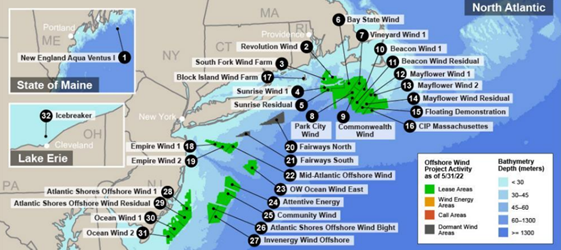 "The off-shore wind market and industry is really ramping up and accelerating,” Shields said. The Biden administration has set a goal to install 30 gigawatts by 2030. There are about 40,000 megawatts (MW) of policy commitments by eight eastern states and a comparable amount in the pipeline. But so far just seven turbines, generating 42 megawatts, have been installed.
"The off-shore wind market and industry is really ramping up and accelerating,” Shields said. The Biden administration has set a goal to install 30 gigawatts by 2030. There are about 40,000 megawatts (MW) of policy commitments by eight eastern states and a comparable amount in the pipeline. But so far just seven turbines, generating 42 megawatts, have been installed.
To reach that 30 GW goal by 2030 would require more than 2,000 wind turbines in U.S. waters and an estimated capital expenditure of more than $100 billion.
The challenge is that global supply chains are at capacity so a domestic supply chain would be needed to help reach these targets. The components for off-shore wind projects are so big that most any port in the U.S. will need significant upgrades, including deeper changes, massive heavy-lift cranes and large upland yards.
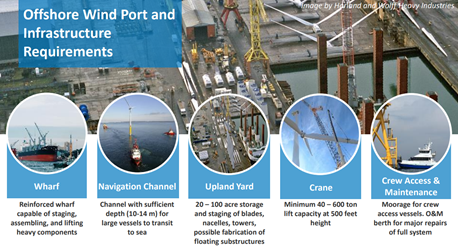 The New Jersey Wind Port in Lower Alloways Creek is the first purpose-built wind port in the U.S. Construction has begun and the first phase is expected to be completed in 2024 and continue into 2028 while creating up to 1,500 manufacturing and operations jobs. The 220 acres of developable land is not constrained by bridges and co-locating with manufacturing and marshalling to avoid extra transportation of components. “If you don’t have marshalling space, you can’t attract the supply chain; these are key areas,” said Storr.
The New Jersey Wind Port in Lower Alloways Creek is the first purpose-built wind port in the U.S. Construction has begun and the first phase is expected to be completed in 2024 and continue into 2028 while creating up to 1,500 manufacturing and operations jobs. The 220 acres of developable land is not constrained by bridges and co-locating with manufacturing and marshalling to avoid extra transportation of components. “If you don’t have marshalling space, you can’t attract the supply chain; these are key areas,” said Storr.
Kooris described off-shore wind industry as an ecosystem, particularly in New England when so many states are in close proximity working together. “This is not going to be each state on their own but together with collective infrastructure and collective purchasing, will grow this industry for the benefit of us all.”